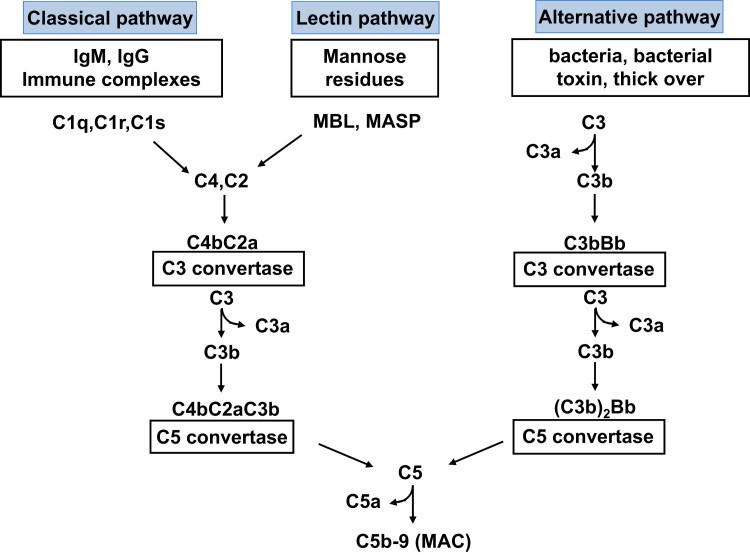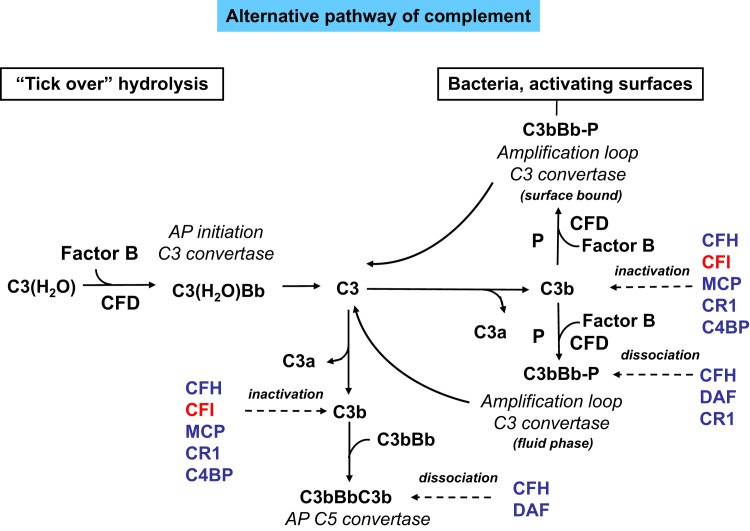Alternative Complement Pathway
Related Symbol Search List
Immunology Background
About Alternative Complement Pathway
The alternative complement pathway is one of the three pathways (alongside the classical and lectin pathways) that form part of the innate immune system's complement system. The complement system is a complex network of proteins that act to recognize and eliminate pathogens, promote inflammation, and assist in the clearance of cellular debris and immune complexes.
The alternative complement pathway is unique among the three pathways because it can be spontaneously activated in the absence of specific antibody recognition. This pathway serves as an early defense mechanism against invading microorganisms, providing rapid and immediate responses to infections.
The activation of the alternative complement pathway starts with the spontaneous hydrolysis of C3, a central component of the complement system, into C3a and C3b fragments. C3b acts as a pivotal molecule in the pathway and can bind covalently to nearby surfaces, including pathogens, through a process called opsonization. Once attached to a surface, C3b can interact with Factor B, leading to its cleavage by Factor D into Ba and Bb fragments. The resulting C3bBb complex forms the C3 convertase, which can cleave additional C3 molecules into C3a and more C3b, amplifying the complement cascade.
The C3bBb complex, also known as the alternative pathway C3 convertase, is relatively unstable and requires regulatory proteins to prevent excessive complement activation on host cells. One such regulatory protein is factor H, which binds to C3b and acts as a cofactor for Factor I, another regulatory protein. Factor I cleaves C3b into inactive fragments, preventing further amplification of the alternative pathway and protecting host cells from complement attack.
The alternative complement pathway can be activated by various triggers, including pathogen surfaces, foreign particles, damaged cells, and certain immune complexes. The amplification loop involving the C3bBb complex ensures efficient pathogen recognition, opsonization, and the generation of inflammatory mediators, such as C3a and C5a, which recruit immune cells and promote inflammation.
The alternative complement pathway plays a crucial role in host defense against infections, particularly against pathogens that evade or resist other immune mechanisms. It also contributes to immune surveillance, clearance of apoptotic cells, and the regulation of adaptive immune responses. Dysregulation or deficiencies in the alternative complement pathway can lead to increased susceptibility to infections, autoimmune diseases, and complement-mediated tissue damage.
 Fig.1 Schematic overview of the complement cascade illustrating the three activation pathways (classical, lectin, and alternative) and the MAC. (Noris M, et al., 2013)
Fig.1 Schematic overview of the complement cascade illustrating the three activation pathways (classical, lectin, and alternative) and the MAC. (Noris M, et al., 2013)
Physiological Functions of Alternative Complement Pathway
The alternative complement pathway, as part of the complement system, serves several important physiological functions in the body. Here are some key functions of the alternative complement pathway:
Pathogen Recognition and Opsonization: The alternative complement pathway plays a crucial role in recognizing and labeling pathogens for destruction. It can directly recognize and bind to certain microbial surfaces, including bacteria, fungi, and viruses, through the binding of C3b to these surfaces. This opsonization process enhances phagocytosis by immune cells, such as macrophages and neutrophils, leading to the elimination of pathogens.
Inflammation: Activation of the alternative complement pathway generates potent inflammatory mediators, such as C3a and C5a. These molecules recruit and activate immune cells, including neutrophils and macrophages, to the site of infection or tissue damage. Additionally, they promote the release of pro-inflammatory cytokines, enhancing the inflammatory response and contributing to the elimination of pathogens.
Clearance of Immune Complexes: The alternative complement pathway helps in the clearance of immune complexes, which are formed when antibodies bind to antigens. C3b can bind to immune complexes, facilitating their recognition and clearance by phagocytic cells, preventing the deposition of immune complexes in tissues, and reducing the risk of autoimmune reactions.
Tissue Homeostasis and Repair: The alternative complement pathway contributes to tissue homeostasis and repair processes. It aids in the clearance of apoptotic cells and cellular debris, preventing their accumulation and promoting tissue regeneration. The pathway also interacts with other systems, such as the coagulation system and the extracellular matrix, influencing wound healing and tissue remodeling.
Immunoregulation: The alternative complement pathway interacts with other components of the immune system, including antibodies, cytokines, and immune cells, to regulate immune responses. It can modulate the activation and functions of lymphocytes, influence the differentiation of immune cells, and contribute to the regulation of adaptive immune responses.
Host Defense against Microbial Infections: The alternative complement pathway acts as a critical component of the innate immune system's defense against microbial infections. It provides an immediate and rapid response to invading pathogens, even in the absence of specific antibodies. By promoting opsonization, inflammation, and the recruitment of immune cells, the alternative complement pathway helps control and eliminate microbial threats.
It's important to note that while the alternative complement pathway plays essential roles in host defense and immune regulation, dysregulation or excessive complement activation can contribute to tissue damage, autoimmune diseases, and inflammatory disorders. The tight regulation of complement activation is crucial for maintaining immune homeostasis and preventing harmful effects on host tissues.
 Fig.2 The alternative pathway of complement activation. (Noris M, et al., 2013)
Fig.2 The alternative pathway of complement activation. (Noris M, et al., 2013)
Available Resources for Alternative Complement Pathway
- At Creative BioMart, we provide an extensive range of products associated with the alternative complement pathway, such as recombinant proteins.
- We also provide customized services based on your specific requirements, whether you are a researcher in academia or the biopharmaceutical industry.
- In addition to our comprehensive product line and services, we offer a wealth of resources that cover various aspects of the alternative complement pathway. These resources encompass involved pathways, protein functions, interacting proteins, articles, research areas, and other relevant topics. They are designed to deepen your understanding and facilitate the application of alternative complement pathway-related knowledge.
At Creative BioMart, we are dedicated to supporting your research and development endeavors in the field of the alternative complement pathway. We encourage you to explore our products, take advantage of our customized services, and utilize our extensive resources to advance your scientific pursuits.
Our Featured Products
Recombinant Human C3, His-tagged
Active Recombinant Human C3 protein, His-tagged
Recombinant Rabbit C3 Protein
Recombinant Swine C3 Protein
Recombinant Human C3AR1 protein, His-tagged
Active Recombinant Human C5 protein
Recombinant Human C5, His-tagged
Recombinant Human C9, GST-tagged
Recombinant Human CFH, His tagged
Recombinant Human CFB, GST-tagged
Recombinant Human ISM2, GST-tagged
Recombinant Human MBL2 protein
If you have any questions, requirements, or cooperation intentions, please feel free to contact us. We very much look forward to working with you and helping you achieve research and commercial success.
References:
- Noris M, Remuzzi G. Overview of complement activation and regulation. Semin Nephrol. 2013 Nov;33(6):479-92.
- Harboe M, Mollnes TE. The alternative complement pathway revisited. J Cell Mol Med. 2008 Aug;12(4):1074-84.
- Thurman JM, Holers VM. The central role of the alternative complement pathway in human disease. J Immunol. 2006 Feb 1;176(3):1305-10.
- Pangburn MK. Initiation of the alternative pathway of complement and the history of "tickover". Immunol Rev. 2023 Jan;313(1):64-70.

